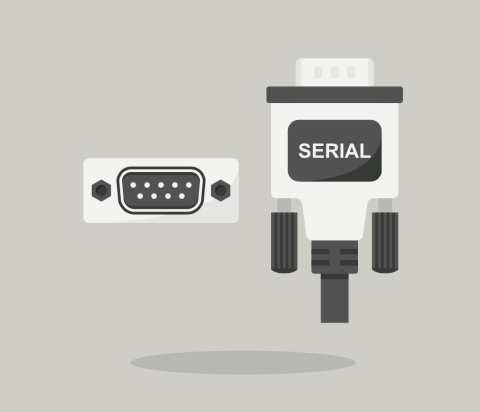Choosing the Right Microphone for Embedded Applications

If you need to capture sound waves for your electrical device to process, you'll need a microphone. However, microphones these days have become very advanced, and there are so many options to choose from. While there are relatively small dynamic microphones, they come with a broad range of options and technologies. They range from relatively simple and popular condenser-type microphones to state-of-the-art sound conversion solutions incorporating internal amplifiers and other electronic processing functionality. In this article, we'll take a look at how to choose the best MEMS microphone for your design.
Dynamic microphones
A dynamic microphone simply consists of a plastic diaphragm, a voice coil, and a permanent magnet. Its operation is based on the same principle as a solenoid, just working principle of microphone in reverse.

The diaphragm is connected to one end of the voice coil, while the other end of the coil is loosely supported around (or within) the magnet. When an alternating sound pressure wave is applied to the diaphragm, this moves the diaphragm, which moves the voice coil so that it alternates in response. Since the voice coil is accelerating through the magnet's magnetic field, an induced voltage is set up across the voice coil's output leads. This voltage can then be used to power a minimal load, or alternatively, its strength can be increased using an amplifier to enable the signal to drive a larger load.
Dynamic microphones are also available that house an internal transformer within the body of the device. This gives them the ability to have either a high- or low-impedance output, and they can switch between the two options.
Dynamic microphones are incredibly rugged, providing smooth and extended frequency responses while not requiring an external power source to drive them. They also perform well over a wide range of temperatures and provide a low-impedance output. This makes them a great low-cost solution across a wide range of applications. Dynamic microphones are typically used in public address systems, hi-fi, and home recording applications.
Carbon microphones
Carbon microphones contain carbon granules that collectively have the useful property that the resistance across the granules changes proportionally to the pressure applied to the granules. This allows them to act as a transducer, which converts sound into an electrical signal when alternating sound waves change the resistance by altering the compressive pressure.
This is a very old microphone type, adopted in early telephony systems and no longer in common usage.
The principal advantage of carbon microphones over other microphone designs is that they can produce high-level audio signals from very low DC voltages without needing any form of additional amplification or batteries. The carbon microphone gives a power gain by using a power supply. This can readily be demonstrated by connecting a battery, microphone, and earphone in series. If the microphone and earphone are brought close together, feedback in the system will cause the earphone to oscillate. This is only possible if the power gain around the loop is greater than unity. The microphone's low-voltage performance is particularly useful in remote locations served by very long telephone lines. The wires' electrical resistance can lead to severe DC voltage drop, limiting the power that can be made available. Almost all electronic telephones need at least three volts of DC to work and will often become ineffective in such situations. In contrast, carbon microphone-based telephones will continue to work when the supply voltage is down to a fraction of a volt.
Carbon microphones are widely used in safety-critical telephony applications such as in the mining and chemical manufacturing industries. Higher line voltages cannot be used due to the risk of sparking and subsequent risk of explosions. Carbon-based telephone systems are also resistant to damage from high-voltage transients, such as those produced by lightning strikes and electromagnetic microphone pulses of the type generated by nuclear explosions. This makes them ideal for backup communication systems in critical military installations and around structures prone to lightning strikes.
Condenser microphones
A condenser microphone is a type of microphone that consists of a pair of charged plates that can move closer or further apart by the variations in air pressure caused by sound waves. In effect, the plates act like a sound-sensitive capacitor.
One plate is typically made from a flexible metallic material or metal-coated plastic that is positively charged by applying an external voltage source. The other plate is made of rigid metallic material fixed in place and earthed, which serves as the microphone's ground.
Condenser microphones are built with an integrated amplifier that is required to operate this type of microphone. A very low-noise, high-impedance amplifier is required, which provides a low output impedance. Without the amplifier, the microphone's output signal would be too low to be useful. As the microphone requires an external power source to charge the capacitive plates, the inclusion of an active amplifier circuit does not place any additional constraints on the device. Always check the datasheet to establish the bias voltage and current requirements for the selected condenser microphone.

Electret microphones
An electret microphone is so named as it uses electrostatic and magnetic properties to function. It may also be referred to as an ECM microphone. It is constructed from a stable dielectric material with a permanently embedded static electric dipole moment. Due to the material's high resistance and chemical stability, the electret's operating life will not be affected by any decay or degradation of its properties. Electrets are commonly made by melting a suitable dielectric material such as plastic or wax (containing polar molecules) and then re-solidifying in a strong electrostatic field. The polarized molecules of the dielectric align themselves to the electrostatic field's direction, producing a permanent electrostatic bias. Modern electret microphones use PTFE in film or solute form to create the electret.

Electret microphones operate in the same manner as condenser microphones, utilizing electrostatically charged materials to act as capacitive plates. The difference is that this type of microphone eliminates the requirement for the external polarizing power supply by using the permanently charged material. It will still require a power source for the integral amplification circuit, with a pull-up resistor (typically around 1k - 10k Ohm) for biasing the capacitor.

The main advantages of using electrets are that they are relatively low-cost components, available in a range of sizes that deliver their output via a low-noise JFET buffer. The devices typically are available in cylindrical form with options for connection using a solder pad, pin, surface mount, or wire lead.
The main disadvantages are that they cannot be reflow soldered as the electret diaphragm cannot withstand high temperatures.
MEMS microphones
MEMS (Micro-Electromechanical System) type microphones are becoming the most common type in the market and are replacing electrets in popularity.
They operate using a pressure-sensitive diaphragm that is etched directly into a silicon wafer by the MEMS processing technique, after which they are named. Usually, they will include an integrated preamplifier as part of the device. Typically, sound energy is converted by the diaphragm by changing the material's capacitance in the same manner as the condenser and electret microphone types. There are also alternate variants that use piezo materials to generate an electrical signal from pressure changes.


As shown in the above picture, sound waves pass through the sound inlet and vibrate the sensor membrane. The integrated ASIC (Application-Specific Integrated Circuit) detects the change in capacitance of the piezo-electric effect, amplifies this signal, and, if necessary, transforms it into a digital output.
The MEMS microphone's main advantages are its ability to withstand high temperatures making it suitable for reflow soldering, improved noise performance than electret microphones in equivalent package size, and a significantly higher performance density than electret microphones thanks to its compact size. MEMS microphones can also operate over higher temperature ranges with better performance across the range. Basic MEMS microphones made of silicon or piezo materials will typically have an operating temperature range of -40oC to +85 oC. A basic electret microphone will typically have an operating temperature range of -20oC to +70 oC. Also, while having a broader operating range, MEMS microphones have a lower sensitivity variation over the range. MEMS microphones have typically +/- 0.5 dB, while Electret microphones have typically +/- 4 dB over their smaller range. The main reason is that the MEMS microphone diaphragm is much smaller than the equivalent electret component, offering as much as a 12 dB advantage in vibration sensitivity.
MEMS microphones are available in different variants so let's explore the options in a little more detail.
Analog MEMS microphones
Analog MEMS microphones do what the name suggests, output analog signals. Most analog MEMS microphones have an internal amplifier, so their output signal is delivered at a usable level with a reasonably low output impedance.


The analog MEMS microphone employs a DC blocking capacitor removing any need for the host circuit to match the MEMS microphone's DC output voltage. Analog MEMS microphones are also biased, so the signal is between ground and supply to avoid any analog sound signal clipping. When implementing the interface circuitry for this device, the designer must ensure that the correct capacitance and resistance values are used so that the inherent high pass filter characteristics so that the desired audio frequency can pass to the circuit with an acceptable level of attenuation



Digital MEMS microphones
Digital MEMS microphones are a type of MEMS microphone with a digital output generated using an ADC integrated with the pre-amplifier. This has the advantage of simplifying integration with microprocessors and microcontrollers, eliminating the need for a separate ADC and the requirement to route analog signals across the PCB between components. This reduces the PCB design's criticality. The output signal will not be sensitive to the PCB track routing or dimensions, coupling effects (inductive and capacitive), and RF Interference sources. This makes Digital MEMS microphones ideal for applications where analog audio signals may be susceptible to interference. Also, the non-sensitivity to coupling effects allows the microphone to be placed any distance from the rest of the system without any performance drop reduction giving the designer more flexibility when designing the PCB.


Digital MEMS microphones also have some useful features. Changing the clock speed to the MEMS digital microphone will change its power mode. Typically, they include a Low Power Mode (LPM) that enables the microphone to be used in an always-on listening mode for keyword spotting and ambient sound analysis. While in this mode, the microphone will consume a minimal amount of current while retaining high electro-acoustic performance.
The main disadvantage of Digital MEMS microphones over other microphone types is the higher component costs. However, the savings from not requiring a separate Codec/Amplifier/ADC circuit and filtering and the associated reduced board space requirements will balance this.
Digital PDM MEMS microphones
The digital MEMS microphones' PDM variant adds a single digital stream using pulse-density modulation (PDM) technology to simplify integration with microcontrollers. This exploits digital MEMS's electrical noise immunity but adds bit error tolerance and a simple hardware interface.



The diagram below shows how two microphones can be connected to the host circuit using a shared clock and data lines. This configuration is often employed when implementing stereo microphones.

MEMS vs. ECM microphones
There are various considerations to take into account when selecting between an ECM and MEMS microphone. The market share for MEMS microphones continues to increase due to the many advantages provided by this newer technology. For instance, space-constrained applications will find the small package sizes available for MEMS microphones attractive. At the same time, a reduction in both PCB area and component cost can be realized thanks to the analog and digital circuits included in the MEMS microphone construction. The relatively low output impedance of analog MEMS microphones and the outputs from digital MEMS microphones are ideal for applications in electrically noisy environments. In high-vibration environments, the use of MEMS microphone technology can reduce the level of unwanted noise introduced by mechanical vibrations.
Furthermore, semiconductor fabrication technology and the inclusion of audio pre-amplifiers facilitate the manufacture of MEMS microphones with closely matched and temperature-stable performance characteristics. These tight performance characteristics are particularly beneficial when MEMS microphones are used in array applications. During product manufacturing, MEMS microphones can also be easily handled by pick-and-place machines and tolerate reflow soldering temperature profiles.
Although MEMS microphones' popularity is proliferating, there are still applications where the use of an electret condenser microphone may be preferred. Many legacy designs have used ECMs, and thus, if the project is a simple upgrade to an existing design, it may be best to continue using an ECM. Options for connecting an ECM to the application circuit include pins, wires, SMT, solder pads, and spring contacts, giving design engineers additional flexibility. If protection from dust and moisture is an issue, it is easy to find ECM offerings with high Ingress Protection (IP) ratings due to their larger physical size. For projects requiring non-uniform spatial sensitivity, ECM products are available with intrinsic directionality, either unidirectional or specific noise-canceling functionality. The wide operating voltage range of ECMs may also be the preferred solution in products with loosely regulated voltage rails.
Digital I2S microphones
I2S (Inter-IC Sound) is a serial bus protocol interface standard used to connect digital audio equipment with microcontrollers or other controller boards to communicate PCM audio data. It's also perfect for connecting digital audio devices together. It utilizes two clock Lines (SCK and WS) and one data line (SD).
Communications are implemented as a stream of data bits, the WS clock signal indicating the start of transmissions, and the SCK clock signal indicating each data bit. Data is sent with the most significant bit (MSB) sent first. The implementation allows either 16-bit or 32-bit data messages. Interoperability between the two is automatically handled by the receiver logic. If the receiver expects 16 bits and received 32 bits, it just ignores the last 16 bits. On the other hand, if it expects 32 bits and only receives 16 bits, it just leaves the least significant bits set to zero.
When implementing the decoding logic, it's important to note that the WS signal changes state on the SCK bit before the MSB of the data is sent. This lets the receiver get ready to switch to the other channel after it has stored the current bit, rather than having to store, switch, and send onward at the same time.


The main advantage is that this type of digital MEMS Microphone output can be connected to an MCU using just three wires as long as the MCU supports the I2S protocol.

Two-channel serial audio interface
The serial audio interface is by far the most common mechanism used to transfer two audio data channels between devices within a system; for instance, from an analog-to-digital converter to a digital signal processor (DSP) and then a digital-to-analog converter. For most media applications, the sound is recorded and processed as a two-channel stereo signal. This makes the requirement for two-channel serial audio interfaces commonplace and managing stereo signals with one processing device significantly advantageous compared with processing the two signals separately.

The Serial Audio Interface consists of two control clocks, the left/right and serial clocks, and the serial audio data line. The left/right clock identifies which channel is currently being transmitted while the serial clock enables decoding the data in that channel. The downside is that the data throughput is halved as the bandwidth is shared. However, for typical audio applications, the upper frequencies can be constrained to the standard human hearing range, which has a relatively modest value upper limit.

TDM audio interfaces
A TDM (time-division multiplexed) audio interface allows multiple audio data channels to be transmitted on a single data line. Useful if multiple digital microphones sending information at low data rates need to be processed by a single controller. The TDM interface is similar to the two-channel serial audio interface but supports more channels (typically four, six, or eight). This is useful for cinematic media systems with surround sound features or professional recording applications. As with the two-channel serial audio interface, the TDM interface consists of two control clocks, a frame synchronization pulse (FSYNC) and a serial clock (SCLK), and the serial audio data line (SDATA).

The FSYNC clock identifies the start of the first channel transmission while the serial clock decodes the data in that channel.
Balanced output vs. unbalanced output
Another factor for designers to consider is whether the digital microphone has a balanced or unbalanced output. Unbalanced signals have an audio signal and a ground, where the ground tries to absorb most of the interference and electrical noise.
By contrast, balanced signals have two audio signal outputs, where one is positive and the other is negative. This technique operates the same as differential pair wiring; any interference present will affect both positive and negative signals equally (assuming they are physically collocated) and cancels out. The output also includes a ground that provides additional protection from unwanted common-mode interference.
Unbalanced audio outputs are most often seen in low-cost consumer applications and signal-processing units. They can also be found used in the signal chains for instruments where short cables are used. Balanced audio output is found in professional studios and anywhere where the use of long cables is required. The maximum length of the unbalanced cable is limited to around ten feet, whereas a balanced cable can be up to a thousand feet long. Above these limits, the effects of noise will noticeably degrade signal integrity.
Of course, it's relatively simple to convert signals from balanced to unbalanced and vice versa if necessary, with off-the-shelf components available to do this if required.
Summary
There are many types of digital microphones available, and which one is right for your application depends on many factors. Things to consider are in what environment the microphone operates. Can it be installed within your device on the PCB, or does it need to be located remotely? What power supply is available for the digital microphone? Can it be provided by the device, or does it need its own supply? What levels of interference will be present in the environment, and how important is it to eliminate interference from the processed signals?
Dynamic microphones offer high-quality sound capture but tend to be too large for most embedded microphone devices. Carbon microphones work at very low voltages and have some niche applications but are increasingly uncommon and challenging to source. Electret microphones are compact, cost-effective, and available in a range of packaging options.
MEMS microphones are undoubtedly the most popular, particularly when they need to be integrated into a PCB design. They offer small size, tolerance to electrical noise, and are more sensitive to sound. This makes them ideal for mobile phones and similar applications. Digital MEMS microphones are, on the whole, preferred more often because they are less sensitive to interference than their analog equivalents. These offer the best flexibility for placement options on a PCB and simplify interfaces with processing components. Digital options also make the processing of multiple microphone signals simple, with serial communications links available that make the integration of multiple signals into a single data stream straightforward. The processing power of even the most basic microcontroller will make short work of digitally processing multiple signals.
However, if there is no requirement for digital signal processing, an analog MEMS microphone with straightforward analog filtering and signal shaping circuitry offers the best solution as long as the board design correctly manages the reduction of noise and interference effects.
Have more questions? Call an expert at Altium and discover how we can help you with your next PCB design.










